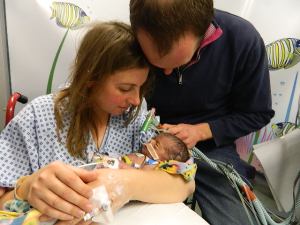The Healing Properties of a Memorial Tattoo
For five years since the death of our baby daughter, my husband has tossed about the idea of a memorial tattoo like a paper frisbee flapping in a turbulent wind of sorrow. Recently, he finally took the plunge. It wasn’t until I saw her name emblazoned on his arm, next to an exact replica of her tiny footprints, that I realized the healing quality of this ink – and why he had been holding back.
We knew from 20 weeks into my pregnancy with Grace that she was unlikely to survive after birth. When she arrived, we had 24 heartbreakingly beautiful hours with her before she left us, ending her short journey in our tear-sodden embrace.

From that moment, our lives changed irrevocably. As anyone who has experienced loss will understand, it is a journey with no destination. Our grief is a chasm that can only be filled with unfulfilled promises and fleeting glances of what should have been.
A few weeks ago, my husband entered a tattoo studio and had our daughter’s name, birthdate and footprints etched on his forearm alongside the words, “if love could have saved you, you would have lived forever.” His choice of wording has a deep significance, because it embodies the helplessness we felt during the battle we and our wonderful doctors fought to give her a chance at life. To see that feeling properly acknowledged on his arm somehow gives it more credence.
Why does death make people ink themselves? Until very recently, the emotional impact and healing properties of a memorial tattoo were lost on me. Yet human beings have been paying tribute to lost loved ones for years in this way, long before Samuel O’Reilly invented the first electric tattooing machine in 1891. Now I understand why.
When my husband showed me his design and its intended placement on his forearm, I said, “It’s in a very visible place. You realize everyone who sees it will ask you about it?” His reply changed my outlook on his journey through grief. “I know, I want them to,” he said simply. Having always believed his grief was quite private to him, his statement made me reconsider. He only ever speaks about Grace with me. Yet perhaps he has wanted to include others all along, but just doesn’t know where to start. The tattoo will provide a jumping off point for those conversations.
For many years, hearing the name Grace called out by a mother in the supermarket or seeing it written in a book, has felt like a punch to the heart. I understand why my husband waited for so long. When it comes to getting a memorial tattoo, you’ve got to be ready to see the name every day and accept the loss. That acceptance can take years.
The word tattoo comes from the Tahitian “tatu,” meaning “to mark something.” As with all tattoos, my husband’s tells a story. It’s the story of our battle to save her, steeped in the deep love and loss we are now so familiar with, all crowned with two little feet. For him, however, there is more to it than that. I carried Grace throughout my 32-week pregnancy, giving me the chance to bond with her in a way my husband couldn’t. His tattoo finally gives him a physical connection with her.
Grace is always with us. We envisage what she would look like and how she would be on a daily basis, using our imaginations to slot her into family life. My husband’s tattoo takes this up a level, propelling her from inside our hearts and minds to a more concrete place. When we sit down to dinner, I see a flash of her name on his arm and suddenly she is with us in a more tangible way than before.
In some ways, the tattoo is more symbolic and healing than a gravestone could ever be. Having found her a unique and prominent place, we don’t need to make a special visit. I find we also talk about Grace more often now; the internalization of our feelings has been dislodged by the symbolic honor to her memory.
My husband waited five years for the jagged, raw edges of his grief to soften before he felt able to see Grace’s name engraved on his arm. The fundamental purpose of any tattoo is to chronicle a story or piece of history on the body. Grace’s short history is now recorded on his arm forever. To see such permanence granted to our baby daughter, who never had the opportunity to make her own mark on the world, has been the most remarkable and unexpected healing process for us both.
There is a popular saying among tattoo artists, as they ink countless punters with the name of their significant others. It goes, “Love lasts forever but a tattoo lasts six months longer.” In the case of a memorial tattoo, which symbolizes an eternity of love and grief, the meaning of those words is equally pertinent – because death lasts forever too.
Follow the author’s blog at New Forest Mum.
